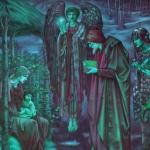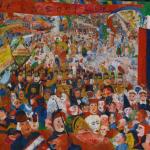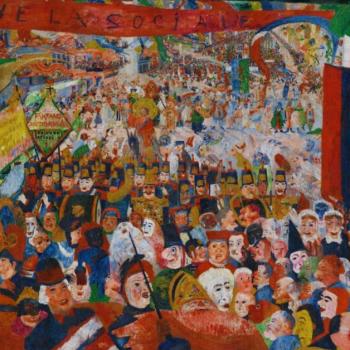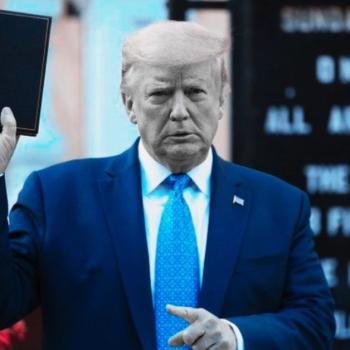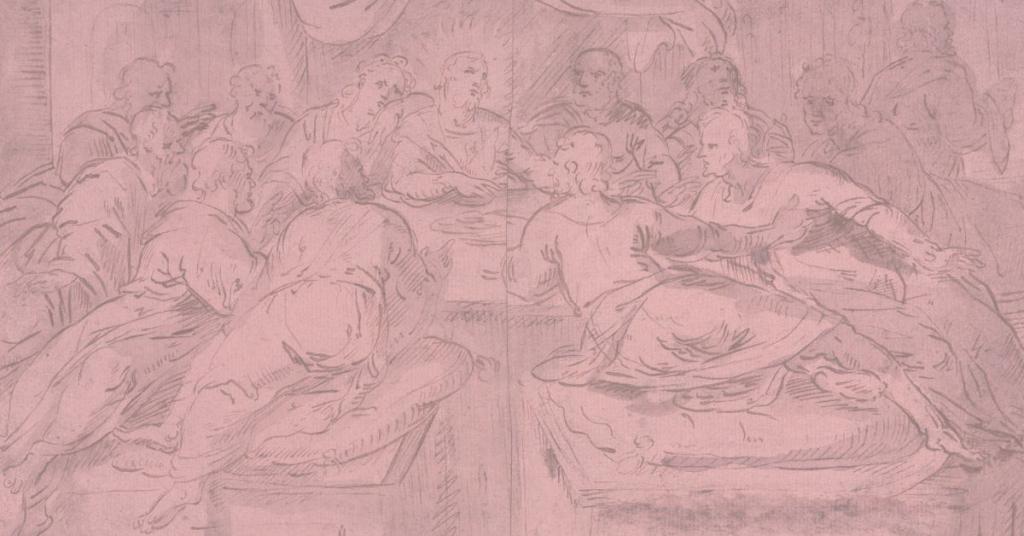 Sometimes when we are post some traditional notions of Christianity, especially as it pertains to ritual, we don’t always know how to engage them and engage them well. Especially, Lent and why it still might matter. If you have hung around this space for any length of time you know that my column is about a post-Christian conversation. What does it mean to engage god after God and faith after belief? These questions become a little more complex (not that they are ever simple) during high holy days throughout the year.
Sometimes when we are post some traditional notions of Christianity, especially as it pertains to ritual, we don’t always know how to engage them and engage them well. Especially, Lent and why it still might matter. If you have hung around this space for any length of time you know that my column is about a post-Christian conversation. What does it mean to engage god after God and faith after belief? These questions become a little more complex (not that they are ever simple) during high holy days throughout the year.
I have spoken often in my work on what it might look like to retain high holy holidays and liturgical calendar moments but with a sense of re-enchantment and renewal. Just because we don’t engage God as we once did doesn’t mean that there still aren’t super meaningful ways to be in transformative conversations with such days, celebrations, and even rituals. And, also, if we are having a post-Christian conversation and not just a post-religion conversation then Christianity’s central figure, Jesus Christ, still really matters. We get to pursue why that is so.
Let’s dive in!
Typically and traditionally, when I think of Lent words like death, ashes, sacrifice, and remembrance come to mind. And that’s what most of us have been taught that Lent is all about, right? And while Jesus didn’t call this time in his own life Lent, I am super interested in what he was up to during the time we have set aside for millennia to represent such words as listed above.
Now Lent usually refers to the forty days Jesus spent in the wilderness, during which he was tempted away from his life’s purpose. While we see this account in the Synoptic Gospels, (Matthew, Mark, and Luke), John seems to have withheld this part of his story. It is impossible to know why with any sense of certainty. We can only assume it didn’t fit his Jesus narrative, which would make sense given his authorial aim and intentions regarding Jesus as the Son of God and Divine Mystery.
So when we are engaging John’s Gospel during the time of Lent what exactly are we engaging?
Let’s address some important parts of helpful descriptions of the author within the text. When I say the phrase, ‘author within the text,’ I am not necessarily referring to the actual or historical John but the ‘John’ the text constructs for us. This is what we are after. And what we know from the text is that ‘John’ is referred to as ‘the beloved disciple.’ Also, traditionally speaking, the Gospel author John has been symbolized with the image of an eagle.
This comes from the book of Revelation in which all the Gospel writers have familiars. John is likened to an eagle. What do we know about the eagle and why might the author of Revelation assign this image to John? Anglican Bishop Michael Marshall says that an eagle is “one that could look straight at the sun and not be dazzled or blinded by it.”[1] This would make sense given Gospel writer John’s relationship to Jesus. He didn’t often miss it as some of the other disciples did on the regular. He had Jesus’ ear and trust. He could look into the sun and see its light; he wasn’t blinded by dreams of grandeur. He looked and listened closely.
After Jesus’ baptism we see him call his first disciples. John the Baptist, his cousin, is still baptizing with water, rooted in Jewish ceremonial washing, as John was a part of a group known as the Essenes who were quite concerned with spiritual purity. But he knew that soon One would come that would baptize with the Spirit, rendering impotent and irrelevant water baptism and a host of other religious rituals. There would be a Christ, a messiah, who would “take away the sins of the world” (1:29). And indeed there was.
Jesus would come removing the barrier the ‘sin of the world’ created. He was about to move past ritual, past sacrifice, past paying homage to the God who lived in the temple, in the Holy of Holies, silently waiting on offerings, residing in an uncommunicative cloud. Jesus was about to change all of that. This wasn’t about personal sin, or even collective wrongdoing. This was about religion and about abolishing and the clearing away of the clutter and debris so called ‘sin’ had required.
Everyone would have access to abundant life. No one would be held back ever again. Sin was going to be redefined and flipped on its head. Ritual was about to become sin. Freedom and love for one another was the only call for disciples of this new life, this new abundant life. “To obey is better than sacrifice.” Prophets like Samuel were such forerunners. But no one was ready for it. They couldn’t see it. They had no vision for it. Except perhaps John. And Jesus knew it.
The Gospel of John can be categorized as introducing the ‘Paschal Mystery,’ which is a phrase we often hear during the season of Lent. Where the old would be replaced by new. Where we don’t always understand the changes, but we follow them anyway. Where we aren’t promised a destination, but we must traverse just the same. What are we following? What are we traversing? Well, perhaps, the way that Jesus has gone. Because he has indeed revealed that he is going before his disciples in preparation of this ‘abundant life.’ But what does that even mean?
This idea of Jesus preparing a place and verses like that of John 14:3 which, unfortunately, has been translated as the Father having many rooms in his ‘mansions’ have typically been used to denote a faraway eternal destination, aka ‘heaven.’ But if we take a look at the Greek and move away from biases such as the King James Version, more modern versions like the New Revised Standard Version delivers a translation to us that reads, “In my Father’s house there are many dwelling places.”
Now this is an important translation prerogative. It isn’t simply a preference, it is hermeneutical integrity. The actual Greek here reads, ‘monai’ which literally translates as ‘dwelling place.’ The connotation at the time would have been an allusion to ‘caravanserais’ which was a ‘resting place’ for travelers. It in no way would have denoted a final destination or ultimate landing. This idea was attributed to the use of wayside inns or staging posts where, as Marshall writes, “travelers on long journeys could spend a night to rest before setting out again.” [2] It was about gaining strength for the journey ahead, while resting from the sojourn you just endured. Jesus perhaps here is likening himself almost to a type of dragoman that might go ahead and make preparation for those that would follow.
So what does this all mean for Christianity and the way we are to follow Christ? What does this mean for Lent? What does this mean for how we have long misinterpreted such a passage? What does this mean for understanding and re-understanding what Jesus came to do? Well, like most travelers, it isn’t about undoing the past or what we have learned and where we have traveled up until this point, but it’s about where we might go next as a result of our ever evolving, vulnerable, and dimensional horizons as we continue on.
There is so much richness in chapters 14-16 of John’s Gospel. I want to spend a little bit of time unpacking some of what we see happening in light of some of these new realities.
In the beginning of John 13 we see Jesus washing the disciples’ feet. If I have to go to one more Christian wedding to see a husband and wife washing each other’s feet I think I’m going to barf. I don’t care who it is or why they are doing it. If they are doing it to imitate Jesus here they may as well not do it at all. Because what they are doing is patterning themselves off of a subjective and ‘lite’ interpretation of the powerful moment taking place and what it is actually invoking.
If you take a look at a simple ground plan of the First Temple you will find three different sections. The first section being the Court, the second the Holy Place, and the third being the Holy of Holies. In the Court area there was an altar of burnt offering as well as a bronze basin for cleaning your feet before you walked into the Holy Place.
After the Holy Place it was only the High Priest that could enter the Holy of Holies and only once a year at that, on Yom Kippur (the Day of Atonement) to burn incense and offer animal blood to absolve their sins and the sins of God’s people (Israel). Also, just so we are clear, the sins that were being atoned for are mostly the unintentional moral slip ups that might happen on a daily basis for any person living their life. The point is there was a washing that needed to happen before anyone could enter into that next holy place, further into mystery, and further towards the God who lives in that place.
So here we see Jesus washing the feet of his disciples to prepare them for the new place of faith that is about to dawn for them and the world. Could Jesus be demonstrating a type of servant-leadership? Well, sure. I guess. But he is attempting to abolish and truly fulfil the law by subverting it in an act of finality that will culminate in the act of all acts of finality on the cross.
What Jesus is doing here is not only fulfilling religion and religious law, but actually bringing it to its end! This is huge! He is inviting his disciples to continue to traverse towards that inner sanctum which is no longer an inner sanctum or a destination at all, but now out there in the world with a new age dawning that will change things forever.
Of course, Peter ever missing things first urges Jesus not to wash his feet (v. 6). He doesn’t quite get what’s happening. Jesus informs him that “You do not know what I am doing, but later you will understand…Unless I wash you, you will have no share with me.” Then Peter goes to the other extreme telling Jesus to wash his whole body then (v.10). He missed it again. Jesus is saying that he is the only one who can truly wash God’s people clean. Because it is a new time now. A time after ritual, after religious rights, hierarchy, law, and rigid customs and observances. Jesus says-Hey you, the God who has lived in the Holy of Holies-guess what? When you look at me, you see God and if you know me you have known God.
Jesus completely upends 3,000 years of Yahweh protocol and sacrament and says in him all of it is fulfilled and if you follow him there is nothing more you need to do. Other than the command he gives, which is to “love one another” (John 13: 34-35).
Jesus says where he is going his disciples cannot follow, not yet, but they will. Peter asks why can’t he follow. Then he exclaims he would die for Jesus (13:36). Peter–always with the all or nothing attitude. But as Jesus continually shows us in John’s Gospel it isn’t about sacrifice. That is not what he is after but they can’t get it through their heads after thousands of years of religious conditioning.
It was about obedience. Obedience to what? Well, to follow him. But what does it mean to follow Jesus? Well, maybe to believe him when he says he has fulfilled the law and therefore abolishing it and the need for it, and believing him when he makes a new and ultimate commandment; to love one another. And if we need more encouragement than that…In John 15:13 we read, “No one has greater love than this, to lay down one’s life for one’s friends.” The years of religion, law, sacrifice, and ritual—it has all led to this and has all been in service of this.
Jesus says a servant is not greater than his master but then says that they are not servants but friends. And will do even greater things that he has done. But what is greater than fulfilling and abolishing the law and religion? I guess that is for us to figure out between our ‘resting places’ along the way, in service of the Way.
We are never invited to a finishing point. Yet we are invited on a journey of a different kind. A journey that lives and moves beyond the ritualist movement between degrees of holiness and separation in ‘the temple.’ Perhaps we don’t understand it all, perhaps we do what we have been asked to do until further sign posts are reached.
Do not get stuck in the Outer Court with its various restrictions on who is in and who is out. Marshall says, “In the Holy of Holies there are no religious props, but only the Shekinah or cloud of ‘unknowing’ signifying in silence the presence of God.” [3]
In Jesus, we no longer have a silent God or perhaps a God at all, at least the God we thought we knew. If we take Jesus at his word, and I think whether we are identifying as Christians or post-Christians, we are claiming to do that in some way, we have to take seriously what is being revealed to us in the story of the beloved and trusted disciple.
In chapter 13 we find Jesus telling his disciples at his final supper that someone will betray him. Jesus is noticeably troubled by this. We are told that “The disciples looked at one another unsure of whom he was speaking” (v. 22). We are then told, “One of his disciples—the one whom Jesus loved—was reclining next to him. Simon Peter therefore motioned to him to ask Jesus whom he was speaking of.” Even the other disciples saw the position of trust and mutuality John occupied in the life of Jesus.
Rather than ask Jesus themselves they employed John, the beloved disciple, and clearly a trusted confidant, to do it. We are told John indeed takes the task on. “So while reclining next to Jesus, he asked him, ‘Lord, who is it?’” (v. 25.). I imagined Jesus leaned over in confidence and whispered in sorrowful resignation, “It is the one to whom I give this bread when I have dipped it in the dish” (v. 26). And, of course, we know the rest of the story. The Gospel writer tells us, “after receiving the piece of bread, he [Judas] immediately went out. And it was night” (v. 30).
Indeed it was night. There was a darkness. There was no light to illuminate the way or Way. Judas had turned his back on it. He was too busy with his preconceived passions and proclivities. You see Judas was most likely part of what we know as the Iscarii, the “people of knives” [4] as they were known. They were a nationalistic movement dedicated to their liberation from Roman rule and occupation.
Judas’ loyalties lie elsewhere. He was to have no part in the new time that was to come. He was too preoccupied in what he could ‘see’ that he couldn’t truly ‘see’ what was right in front of him, bringing new depth to Scripture passages that are often exploited for particular religious and ecclesial gain like 2 Corinthians 5:7, “For we walk by faith, not by sight”, and Hebrews 11:1, “Now faith is the assurance of things hoped for, the convictions of things not seen.”
I’m not sure where to end this today. I know I have thrown so much out there and this is more of a Bible-y post than I usually write. But why not explore some of these realities at Lent? Why not ask the questions that the disciples asked? Where are you going? Can I come with? When can I go? What is the instruction or command? Jesus’ story is up for this task. John’s Gospel can handle our questions. And all we can hope for is that we can also be such a beloved disciple that we may look into the sun and rather than be blinded by it, distracted by its bedazzling nature, we fly high with it, follow its light, rest when it is dark, and re-awaken to continue on as it rises each morning.
Maybe Lent and why it still might matter is a good enough question to be asking after all. I’ll let you be the judge. Blessings as you think and ponder further into what I have offered here.
*This is part of a six-week Lenten series I am posting on my patreon. If you would like to journey with us through Lent click here for more.
[1] Michael Marshall, Lent with the Beloved Disciple: The 2024 Lent Book. (London: Bloomsbury, 2023 ) 13.
[2] Ibid, 17.
[3] Ibid, 55. [4] Ibid, 65.

